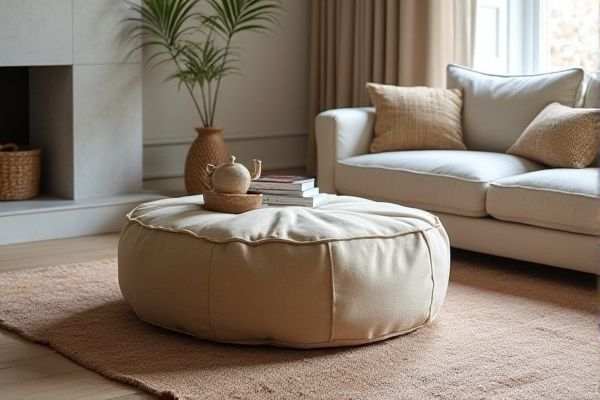
Cube ottomans offer structured, modern aesthetics and versatile functionality, fitting seamlessly into minimalist or contemporary spaces, while round ottomans provide softer edges and a more casual, inviting feel ideal for cozy living rooms or family areas. Explore the rest of the article to discover which ottoman shape best complements your home decor and lifestyle needs.
Table of Comparison
| Feature | Cube Ottoman | Round Ottoman |
|---|---|---|
| Shape | Square or cubic | Circular or cylindrical |
| Design Style | Modern, geometric | Classic, versatile |
| Space Efficiency | Compact, fits corners well | Requires more floor space |
| Functionality | Seating, footrest, storage | Seating, footrest, sometimes storage |
| Comfort | Firm, structured support | Soft, cushioned for comfort |
| Material Options | Leather, fabric, faux fur | Fabric, leather, microfiber |
| Best Use | Modern rooms, minimalistic decor | Traditional, cozy interiors |
| Price Range | Moderate to high | Low to moderate |
Introduction to Ottomans: Cube vs Round
Cube ottomans provide a modern, structured look with their sharp edges and uniform shape, making them ideal for minimalist and contemporary interiors. Round ottomans offer a softer, more inviting aesthetic with smooth curves, enhancing comfort and flow in living spaces. Both styles serve as versatile furniture pieces for seating, storage, or footrests, but their shape influences room dynamics and design emphasis.
Key Design Differences
Cube ottomans feature clean, angular lines that create a modern and structured appearance, while round ottomans offer a softer, more organic shape that complements cozy and casual interiors. The cube design provides versatile functionality with its flat surface, making it ideal for use as a coffee table or extra seating, whereas the round ottoman emphasizes comfort and fluidity in design, often serving as a footrest or decorative accent. Your choice between cube and round ottomans should consider the overall room aesthetic and practical use, balancing style with functionality.
Space Optimization: Shape and Size
Cube ottomans offer superior space optimization due to their angular shape, fitting neatly into corners and aligning flush with other furniture to maximize room layout efficiency. Round ottomans, while visually softer and easier to maneuver around, occupy more space without providing precise alignment options, limiting their use in compact areas. Selecting a cube ottoman enhances storage and seating versatility in small or irregularly shaped rooms by utilizing every inch effectively.
Versatility and Functionality
Cube ottomans offer versatile functionality with their flat surfaces, making them ideal as extra seating, footrests, or even side tables in your living space. Round ottomans provide a softer, more flexible shape that enhances flow in tight areas and serves as an inviting centerpiece or casual seating option. Choosing between cube and round ottomans depends on your room layout and whether you prioritize multi-use practicality or smooth, adaptable design.
Style and Aesthetic Appeal
Cube ottomans offer a modern, geometric appeal with sharp lines that complement minimalist and contemporary interiors, creating a structured and streamlined look. Round ottomans bring softness and a classic vibe with their curved edges, enhancing cozy and inviting atmospheres while providing visual balance in eclectic or traditional settings. Choosing between cube and round ottomans depends on the desired stylistic impact, whether emphasizing angular sophistication or embracing organic fluidity.
Comfort and Ergonomics
Cube ottomans provide firm, even support ideal for maintaining good posture and ease of sitting or resting feet, while round ottomans offer softer, cushioned edges that enhance comfort through ergonomic contouring. The angular design of cube ottomans supports stability and alignment, making them suitable for workspaces or seating areas requiring upright seating. Round ottomans excel in living rooms and relaxation spaces by promoting a natural leg position and reducing pressure points, contributing to overall ergonomic comfort.
Best Uses for Cube Ottomans
Cube ottomans offer versatile seating and storage solutions ideal for small living spaces and modular furniture arrangements. Their defined edges and flat surfaces make them perfect for use as side tables or footrests in modern or minimalist interiors. Cube ottomans also work well in creating organized, multi-purpose zones where both comfort and functionality are priorities.
Best Uses for Round Ottomans
Round ottomans offer versatile seating and serve as ideal coffee tables or footrests in living rooms and lounges due to their smooth edges and inviting shape. Their circular design enhances flow in small or crowded spaces, making them perfect for cozy corners or dining areas where movement is frequent. Upholstered round ottomans with storage compartments provide functional elegance, combining comfort with space-saving organization.
Material and Durability Comparison
Cube ottomans often feature sturdy hardwood frames and dense foam padding, providing excellent durability and firm seating. Round ottomans typically use softer materials like polyester or velvet upholstery with less rigid internal structures, prioritizing comfort over long-term wear resistance. Both designs incorporate durable fabrics, but cube ottomans generally withstand heavy use better due to their solid construction and reinforced corners.
Choosing the Right Ottoman for Your Space
Cube ottomans offer a modern, structured look with straight edges that fit well in minimalist or geometric-themed rooms, providing ample surface area for seating or storage. Round ottomans bring softness and fluidity to your space, ideal for creating a cozy, inviting atmosphere while allowing easy movement around the furniture. You should consider the size, shape, and function of your room when choosing between a cube or round ottoman to enhance both style and usability effectively.
 homyna.com
homyna.com